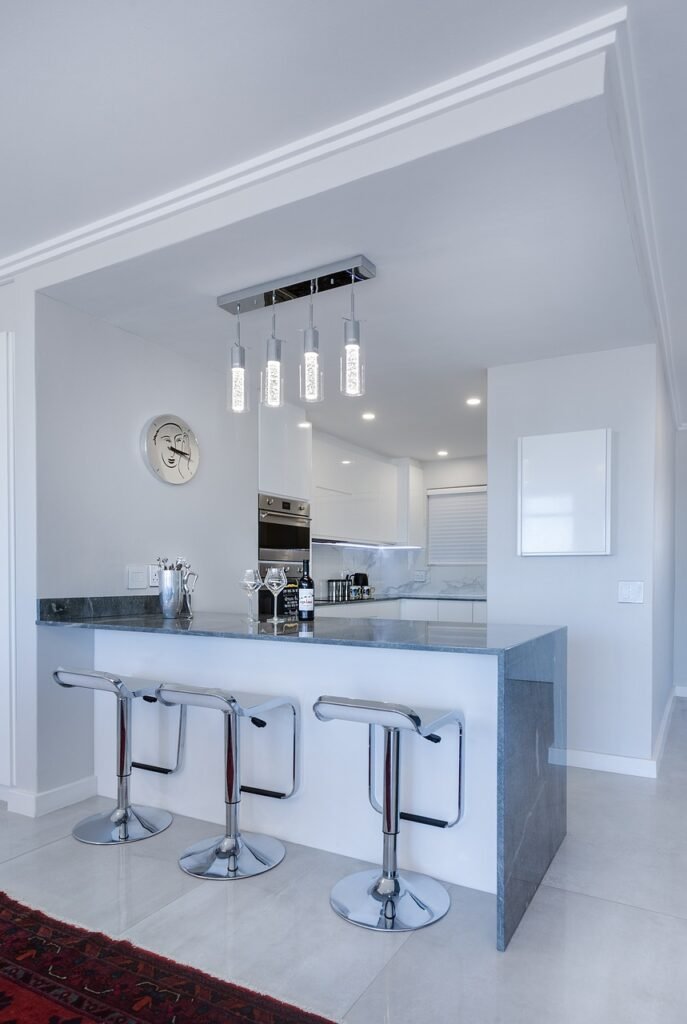Imagine stepping into a kitchen that is beautifully lit, enhancing every detail and creating a warm and inviting ambiance. With the right lighting, you can transform your kitchen into a space that not only serves its practical purpose but also radiates style and sophistication. In this article, we will explore some tips and best practices for creating the perfect kitchen lighting, so you can enjoy a well-lit and visually stunning culinary haven. From the choice of fixtures to the placement of lights, we’ve got you covered. So get ready to illuminate your kitchen in the most delightful way!

This image is property of pixabay.com.
Assess your lighting needs
When it comes to lighting your kitchen, it’s essential to first assess your lighting needs. Consider the purpose of your kitchen lighting – is it mainly for functionality or aesthetics? Do you want to create a bright and energizing space or a cozy and intimate atmosphere? Understanding your lighting goals will help guide your decisions throughout the process.
Take into account the natural light sources in your kitchen. Does your kitchen have large windows that let in plenty of natural light during the day? If so, you may want to utilize that natural light and focus more on accent and ambient lighting for the evenings. On the other hand, if your kitchen lacks natural light, you may need to prioritize task lighting to ensure optimal visibility.
Identify areas in your kitchen that require focused task lighting. From food preparation to cooking and washing dishes, certain tasks require more light than others. Assess your work areas and determine where additional lighting is needed to make your tasks easier and more efficient.
Consider the ambiance you want to create in your kitchen. The right lighting can enhance the overall mood and atmosphere of your space. Do you want a warm and cozy ambiance or a bright and invigorating feel? Evaluating the ambiance you want will help you select the appropriate lighting fixtures and bulbs.
Choose the right types of lighting fixtures
Understanding the different types of kitchen lighting is crucial in achieving the perfect lighting design. There are generally four types of lighting – overhead/general lighting, task lighting, accent lighting, and ambient lighting. Each type serves a specific purpose and contributes to the overall lighting scheme.
Start by selecting overhead/general lighting fixtures. These fixtures provide overall illumination to the kitchen and are often installed on the ceiling. Consider options such as recessed lights, pendant lights, or flush-mount fixtures. The type of fixture you choose will depend on your kitchen’s style, ceiling height, and personal preference.
To add task lighting, opt for under cabinet lights. These lights are installed beneath the upper cabinets and illuminate the countertops, making it easier to see while working. LED strip lights or puck lights are popular choices for under cabinet lighting as they provide focused and efficient illumination.
Consider accent lighting for decorative purposes. This type of lighting highlights specific features in your kitchen, such as artwork or architectural elements. Options for accent lighting include track lights, wall sconces, or recessed lights with adjustable trims. Adding accent lighting can add depth and visual interest to your kitchen.
Utilize ambient lighting to create a warm and inviting atmosphere. This type of lighting fills the space with a soft and diffused glow, reducing harsh shadows and creating a cozy ambiance. Chandeliers, wall sconces, or floor lamps are great choices for ambient lighting. Incorporating dimmers with ambient lighting fixtures can allow you to adjust the brightness as needed.
Determine the ideal placement of lighting fixtures
The placement of your lighting fixtures plays a significant role in the overall functionality and aesthetics of your kitchen lighting. Consider the layout of your kitchen and the different work areas that require adequate lighting.
Ensure even distribution of light throughout the kitchen. Avoid having areas that are significantly darker or brighter than others. Ideally, the light should be balanced and evenly spread across the space to create a harmonious environment.
When placing fixtures, be mindful of shadows on work surfaces. Shadows can make it challenging to see while chopping vegetables or reading a recipe. Position overhead lighting or under cabinet lights strategically to minimize shadows and provide optimal task lighting.
Think about the functionality of each area in your kitchen. For example, if you have a central island that serves as a prep area, consider installing pendant lights directly above it to provide focused lighting. By placing fixtures strategically, you can ensure that each area in your kitchen has the appropriate amount of light for its intended purpose.
Take into account specific kitchen features that may require specialized lighting. For instance, if you have a display shelf for showcasing glassware or a wine rack, consider installing accent lighting to highlight these features. By tailoring the lighting to specific elements in your kitchen, you can enhance their visual impact.
Choose the right light bulbs
Selecting the right light bulbs is essential to achieve the desired ambiance and functionality in your kitchen. There are different types of light bulbs available, each with its own set of characteristics and benefits.
Understand the different types of light bulbs. Incandescent bulbs produce warm, soft light but are less energy-efficient and have a shorter lifespan. LED bulbs are energy-efficient, long-lasting, and offer a wide range of color temperatures. Compact fluorescent bulbs (CFLs) are also energy-efficient but may take a few moments to reach full brightness.
Consider the color temperature of the light bulbs. Color temperature is measured in Kelvin (K) and determines the color appearance of the light emitted. For a warm and cozy ambiance, choose bulbs with a lower color temperature (around 2700-3000K). If you prefer a bright and energizing feel, opt for bulbs with a higher color temperature (around 3500-4000K).
Take energy efficiency and longevity into account. LED bulbs are the most energy-efficient option and have a significantly longer lifespan compared to traditional incandescent bulbs. While LED bulbs may have a slightly higher upfront cost, their energy savings and longevity make them a worthwhile investment.
Ensure compatibility with your lighting fixtures. Different fixtures may require specific types of light bulbs, such as screw-in bulbs or tube bulbs. Be sure to check the specifications of your lighting fixtures to ensure proper compatibility.
Consider using dimmable bulbs for versatility. Dimmable bulbs allow you to adjust the brightness according to your needs and preferences. Adding a dimmer switch to your kitchen lighting can help create different moods and accommodate various activities.

This image is property of pixabay.com.
Enhance the kitchen lighting design with layers
Creating a well-rounded lighting design involves incorporating different layers of lighting. Layering general, task, and accent lighting ensures that each element in your kitchen is adequately illuminated and contributes to the overall ambiance.
Start by creating a balanced combination of lighting. By blending different types of lighting, you can achieve a layered and multidimensional look. Avoid relying solely on overhead lighting or under cabinet lights – instead, aim for a mix of both to create depth and visual interest.
Layer general, task, and accent lighting strategically. General lighting, such as overhead fixtures, provides overall illumination. Task lighting, like under cabinet lights, caters to specific activities. Accent lighting highlights focal points or architectural features. By combining these layers, you can create a lighting scheme that is both functional and visually appealing.
Use lighting to highlight architectural features in your kitchen. If you have unique architectural elements like exposed brick walls, a vaulted ceiling, or open shelving, consider incorporating accent lighting to draw attention to these features. This not only adds visual interest but also creates a focal point in the space.
Utilize focal point lighting to create visual interest. If you have a particular area in your kitchen that you want to highlight, such as a beautiful backsplash or a statement piece of artwork, use focused lighting to draw attention to it. Track lighting or adjustable wall sconces are great options for highlighting focal points in your kitchen.
Consider adding lighting controls for flexibility. Installing lighting controls, such as dimmer switches or smart lighting systems, allows you to adjust the intensity and color temperature of your lights. This gives you the flexibility to adapt the lighting to different activities, moods, or times of the day.
Incorporate natural light effectively
Maximizing natural light in your kitchen can bring a refreshing and inviting atmosphere. Here are some tips on utilizing natural light effectively:
Maximize natural light by choosing appropriate window treatments. Opt for light-colored curtains or blinds that allow natural light to penetrate while still providing privacy. Sheer curtains or blinds with adjustable slats are excellent choices as they allow you to control the amount of light entering the space.
Use reflective surfaces to bounce light around the kitchen. Consider adding mirrors, glass backsplashes, or glossy cabinets to reflect natural light and make the space feel brighter and more open. Reflective surfaces can help distribute natural light into darker corners of the kitchen.
Avoid blocking windows with furniture or cabinets. Placing furniture or cabinets in front of windows can obstruct natural light from entering the kitchen. Keep windows clear and open to maximize the amount of natural light flowing into the space.
Consider installing skylights or solar tubes for additional natural light. If your kitchen lacks windows or doesn’t receive much natural light, consider adding skylights or solar tubes. These features allow sunlight to enter the space from above, providing a natural and energy-efficient light source.
Create a seamless transition between natural and artificial light. When designing your lighting scheme, aim for a balance between natural and artificial light. Use artificial lighting to supplement natural light during darker periods of the day, and ensure that the artificial lighting complements the natural light to create a cohesive and harmonious environment.

This image is property of pixabay.com.
Pay attention to lighting for specific kitchen tasks
Different areas and tasks in the kitchen require specific lighting considerations. Here are some tips on optimizing lighting for common kitchen tasks:
Optimize lighting over the sink. Install a task light directly above the sink to ensure sufficient illumination for washing dishes and food preparation. Consider a pendant light or a well-positioned recessed light.
Ensure sufficient lighting for food preparation. Your countertop should be well-lit to facilitate safe and efficient food preparation. Under cabinet lights or recessed lights focused on the countertop can provide the necessary task lighting.
Add focused lighting for cooking on the stovetop. A properly illuminated stovetop is essential for safe and precise cooking. Consider installing a range hood with built-in lighting or pendant lights directly above the stovetop.
Include lighting for the kitchen island or dining area. If you have a kitchen island or a designated dining area, ensure proper lighting for these spaces. Pendant lights or a chandelier can serve both functional and decorative purposes.
Consider lighting solutions for entertaining. If your kitchen doubles as a gathering space, think about incorporating lighting that sets the mood for entertaining. Dimmable lights or string lights can create a warm and inviting atmosphere.
Enhance safety and functionality with proper lighting
In addition to aesthetics, kitchen lighting also plays a vital role in ensuring safety and functionality. Here are some tips to enhance safety and functionality with proper lighting:
Install adequate lighting for navigating the kitchen. Make sure the main pathways in your kitchen are well-lit to prevent accidental trips and falls. Overhead lighting or wall sconces along the walkways can provide the necessary illumination.
Include lighting for high-traffic areas to prevent accidents. Areas such as the entrances/exits, refrigerator, and sink should have sufficient lighting to prevent accidents. Consider task lighting or motion sensor lights in these high-traffic areas.
Consider motion sensor lights for convenience. Motion sensor lights are a convenient and energy-efficient option for areas such as pantry closets or cabinets. They turn on automatically when they detect movement, providing instant illumination.
Ensure proper lighting for reading recipes or labels. If you often refer to cookbooks or read labels while cooking, make sure you have adequate task lighting in these areas. Under cabinet lights or adjustable wall-mounted lights can be positioned to provide focused lighting for reading.
Use lighting to highlight potential hazards. Identify any potential hazards in your kitchen, such as sharp corners, steps, or low-hanging objects, and ensure they are well-lit to minimize the risk of accidents. Install task lighting or use adjustable fixtures to direct light towards these areas.
Consider the style and aesthetics of your kitchen
When selecting lighting fixtures, it’s crucial to consider the style and aesthetics of your kitchen. The lighting should seamlessly integrate with the overall design and enhance the visual appeal of the space.
Match lighting fixtures to the overall kitchen design. Consider the style of your kitchen – whether it’s modern, traditional, or rustic – and choose lighting fixtures that complement that style. For example, sleek and minimalist pendant lights work well in a modern kitchen, while vintage-inspired chandeliers can add charm to a traditional kitchen.
Select fixtures that complement the color scheme. Take into account the colors used in your kitchen, such as the cabinetry, countertops, and backsplash. Choose lighting fixtures in finishes and materials that harmonize with these color schemes. For example, if your kitchen features stainless steel appliances, consider brushed nickel or chrome fixtures.
Choose a style that reflects your personal taste. Your kitchen lighting should reflect your personal style and preferences. Whether you prefer a sleek and contemporary look or a more eclectic and colorful ambiance, select fixtures that align with your aesthetic vision.
Consider the size and scale of the lighting fixtures. The size and scale of your lighting fixtures should be proportionate to the size of your kitchen. Avoid oversized fixtures that overwhelm the space or undersized fixtures that get lost in the background. Take measurements and consider the height of your ceilings to ensure the fixtures are well-suited for the kitchen.
Ensure the lighting enhances the overall ambiance. Ultimately, the lighting in your kitchen should contribute to the overall ambiance you want to create. The fixtures should cast the right amount of light and create a warm and inviting atmosphere. Consider the placement, intensity, and color temperature of the lighting to achieve your desired ambiance.
Seek professional advice if needed
If you find yourself overwhelmed or unsure about designing your kitchen lighting, don’t hesitate to seek professional advice. Lighting designers or electricians can offer valuable insights and expertise to ensure that your lighting layout and placement are optimal.
Consult a lighting designer or electrician to discuss your lighting needs and goals. They can provide professional recommendations based on your specific kitchen layout, style, and budget. These experts can also offer advice on lighting technologies, energy-efficient alternatives, and the latest trends in kitchen lighting.
Get expert opinion on lighting layout and placement. An experienced professional can analyze your kitchen’s layout and functionality to determine the best placement for each lighting fixture. They can help you achieve an even distribution of light, avoid shadows, and maximize the effectiveness of your lighting design.
Discuss options for customized lighting solutions. If you have unique requirements or preferences, a lighting professional can explore customized lighting solutions for your kitchen. Whether it’s integrating smart lighting controls, incorporating specialty fixtures, or creating a specific lighting theme, they can help bring your vision to life.
Seek advice on energy-efficient lighting alternatives. Energy-efficient lighting not only helps reduce your environmental impact but also saves you money in the long run. A lighting expert can guide you towards energy-efficient alternatives, such as LED bulbs and fixtures, that meet your lighting needs while minimizing energy consumption.
Consider professional installation for complex setups. If your kitchen lighting design involves complex setups, such as recessed lighting or extensive wiring, it’s advisable to hire a professional for installation. They have the knowledge and expertise to ensure that the lighting is installed safely and according to local electrical codes.
Creating the perfect kitchen lighting requires careful consideration of your lighting needs, choosing the right fixtures and bulbs, strategically placing lighting fixtures, and enhancing safety and functionality. By incorporating layers of lighting, utilizing natural light effectively, and considering the style and aesthetics of your kitchen, you can achieve an inviting and practical lighting design. And if you need guidance along the way, don’t hesitate to consult a lighting professional for expert advice.
